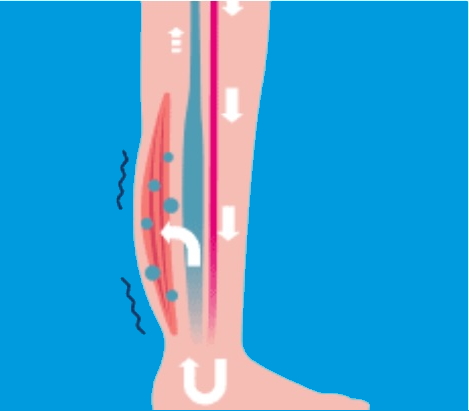Leg Swelling/Edema
LEG SWELLING/EDEMA Q & A
What Is Leg Swelling?
Leg swelling is generally caused by edema or inflammation:
- Edema is buildup of fluid in the leg, especially feet, ankles, and calves. Its origins are often the result of both lymphatic dysfunction and vascular disease. Poor circulation from venous malfunction causes lymph fluid to collect, and remain, in the lower legs. Treating the vascular condition and improving blood flow can reduce edema.
- Leg swelling due to inflammation is generally a result of injury, such as a broken bone or sprain.
What Are Edema Symptoms?
Symptoms of edema include:
- Noticeable swelling in legs, especially feet, ankles, and lower legs, due to gravity
- Skin pigmentation changes
- Discomfort and pain in swollen area, especially after long periods of sitting or standing


Frequently Asked Questions
Leg Swelling/Edema Patient Education
What Causes Edema?
Edema is caused a malfunction of the lymphatic system called lymphedema. In patients with lymphedema, lymph fluid builds up in the soft tissue, causing swelling. Poor circulation caused by vascular disease contributes to edema, making it difficult for the body to move fluid out of the legs. Some underlying vascular conditions trigger edema are:
- Deep vein thrombosis (DVT) – A serious condition in which a blood clot forms deep inside leg veins. If left untreated, the clot can travel through the body, causing an embolism. If edema is caused by DVT, the swelling will likely only occur in one leg, not both.
- Thrombophlebitis – Blood clots form in blood vessels near the surface of the skin
- Chronic venous insufficiency (CVI) – Valves in veins malfunction and blood flow stops working properly, causing blood to pool and veins to swell.
When edema is due to vascular disease, treating the veins can reduce swelling and discomfort.
Can Edema Be Reduced?
It is important to understand the cause of edema, so visiting a vascular specialist for a diagnosis is the first step. If vascular disease is an underlying factor leg swelling, physicians will recommend a treatment plan. The first line of treatment may be a conservative approach, but for more severe cases and conditions, minimally invasive vein interventions may be required to improve circulation and reduce edema.
Some additional steps include:
- Elevating legs above the heart, with gravity helping to improve circulation
- Living a healthy lifestyle and improving overall health
- Regular exercise, to help legs release fluid
- Reducing salt in the diet
- Losing weight
- Prescribed medications to reduce swelling
- Compression stockings
- Lymph drainage massage and exercises
What Are Risk Factors for Edema?
Risk factors for edema include:
- Age
- Extra weight/obesity
- Standing for long periods of time
- Long trips and airplane journeys
- Being pregnant
- Certain medications, including steroids, birth control and hormone replacement therapy
Does Edema Need Treatment?
It is important to get diagnosed for the underlying cause of edema. If a potentially serious condition is present, such as deep vein thrombosis (DVT), it must be addressed quickly. Even nonemergency issues related to leg swelling still need prompt care. Treatment for vascular disease will open blood flow and improve circulation, bringing relief to swollen, achy legs. Also, treatment will enable patients to be more active again, improving quality of life.
What Are Edema Treatments?
Endovenous ablation, microphlebectomy, and sclerotherapy are minimally invasive treatments using advanced technology to treat diseased veins and improve blood flow to the legs.
What to Expect from Edema Treatments?
Treatments for edema work by destroying, sealing off, or removing troublesome veins, so blood goes through healthy vessels instead. At Alliance, we use the latest protocols in minimally invasive procedures. Since only a small incision is needed, there are no stitches. Patients of edema treatments will be able to go home the same day as the procedure. Also, recovery time is much shorter than traditional surgery, so daily activities can often be resumed much faster than with traditional surgery.
As an interventional radiologist who specializes in vascular disease, Dr. Jilbert Eradat has experience in treating patients with edema and the vein conditions that can cause it. Dr. Eradat will perform a detailed clinical evaluation that may include lab testing and vascular testing such as duplex ultrasound to determine the cause of venous disease and recommend appropriate treatment.


631 West Avenue Q, Suite A
Palmdale, CA 93551
Phone 661-480-5956
Fax 661-480-5976
Hours
- Monday–Friday
8 am – 5pm
Resources
Connect

